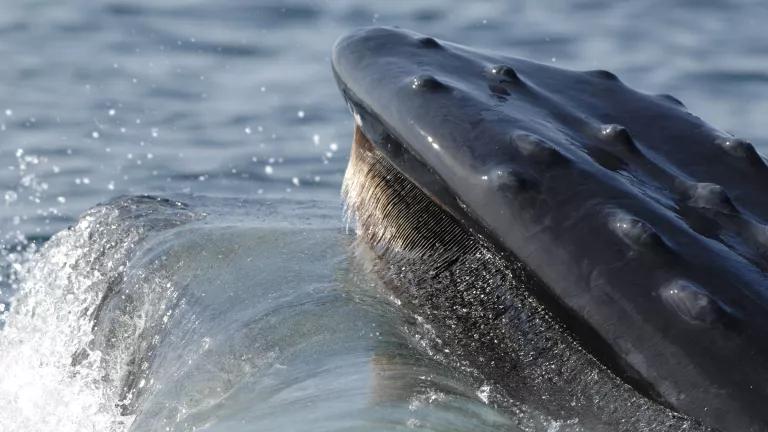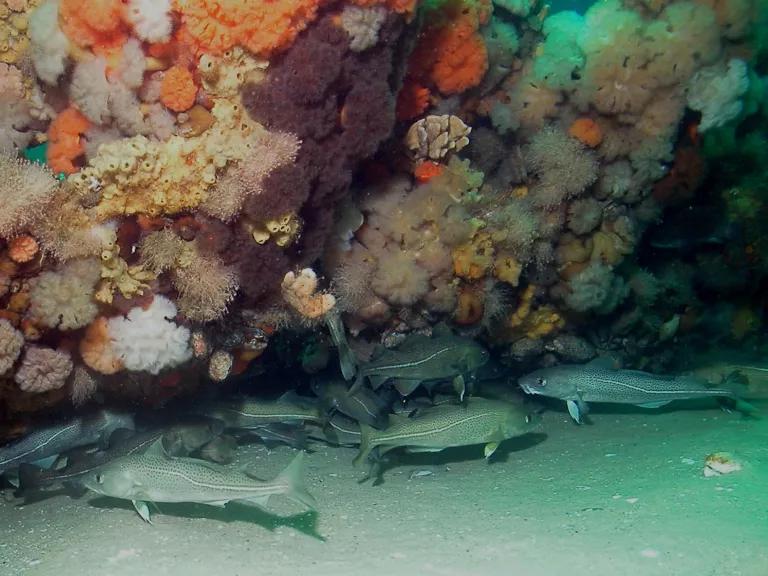NOAA Fails to Protect Stellwagen Bank National Marine Sanctuary
Stronger protection of national marine sanctuaries will help thousands of species better adapt to what the future has in store. The agency is obligated to act.

A humpback whale feeding in Stellwagen Bank National Marine Sanctuary at the mouth of Massachusetts Bay.
NOAA
Marine heat waves. Coral bleaching. Fish populations struggling to move into colder, deeper waters. Marine biodiversity on the decline. The evidence is clear. The ocean is experiencing major impacts. It is absorbing more than 90 percent of the heat generated by burning fossil fuels and a quarter of carbon dioxide emissions, which together make the ocean more acidic, oxygen-deprived, and too warm. While we work to curb emissions, we need to keep ocean ecosystems healthy so they can better withstand these impacts.
We can start by ensuring that America’s treasured underwater parks receive the protections they deserve.
Fifty years ago, Congress established the National Marine Sanctuary System to designate and protect marine areas with special ecological, cultural, and historical significance. The United States has designated 15 sanctuaries, and our nation’s ocean agency—the National Oceanic and Atmospheric Administration (NOAA)—is responsible for their health.
But NOAA’s recent management plan for Stellwagen Bank National Marine Sanctuary does not include any concrete requirements to restore and protect this treasure.
NOAA is obligated to protect valuable habitat and the threatened and endangered species at Stellwagen Bank National Marine Sanctuary
This remarkable sanctuary off Massachusetts in the Gulf of Maine supports more than 570 species, including seabirds, sea turtles, 22 species of marine mammals, and numerous fish species. Stellwagen Bank’s waters are not immune to global pressures though, and, in fact, the Gulf of Maine is warming faster than 96 percent of the global ocean. The stress our ocean is experiencing makes protection of places like Stellwagen Bank particularly imperative.
Every five years, NOAA is required to revise the sanctuary management plan and regulations as necessary to fulfill the purposes and policies of the National Marine Sanctuaries Act. A central purpose and policy of the act is “to maintain the natural biological communities in the national marine sanctuaries, and to protect and, where appropriate, restore and enhance natural habitats, populations, and ecological processes,” according to 16 U.S.C. Section 1431(b)(3). Indeed, where there is a conflict with other purposes, the act makes clear that its primary objective is resource protection. See 16 U.S.C. Section 1431(b)(6).

Atlantic cod take shelter under the Palmer wreck in Stellwagen Bank National Marine Sanctuary.
Matthew Lawrence/NOAA
NOAA’s management plan for Stellwagen has not been updated since 2010. Development of a new, updated management plan presents an opportunity for concerted conservation action, reflective of the most current scientific understanding. NOAA itself has acknowledged the need:
- There has been measurable degradation of habitat quality over the past 10 years, primarily due to direct impacts of commercial fishing but also as a result of increasing noise levels that interrupt behavior and communication of many marine species;
- Human activities, such as shipping traffic and commercial and recreational fishing, continue to impact habitat, living resources, and maritime heritage resources in the sanctuary;
- There is degradation of acoustic habitat for focal species in the sanctuary, such as humpback whales and critically endangered North Atlantic right whales, which already face serious threats from entanglement and being struck by vessels; and
- Fishing gear has impacted nearly every maritime heritage resource in the sanctuary, reducing their historical, archaeological, scientific, or educational value.
See Final Stellwagen Bank Management Plan, page 8.
In response to the science, NRDC calls for NOAA to:
- Implement mitigation measures to protect whales and other marine life from noise impacts in one of the nation’s loudest sanctuaries;
- Require vessels to travel at speeds of 10 knots or less in the sanctuary and provide better speed surveillance and enforcement in order to prevent lethal vessel strikes of vulnerable whales; and
- Request that the New England Fishery Management Council adopt regulations to protect the sanctuary’s spawning cod stock, forage species like sand lance, and bottom habitat; if the fishery management council fails to act, NOAA should adopt regulations under the National Marine Sanctuaries Act to protect those resources.
NOAA failed to incorporate the needed sanctuary protections
NOAA issued its final Stellwagen Bank management plan on August 7, 2023. Unfortunately, the updated plan, which will likely guide sanctuary management for a decade or more, contains not a single concrete, on-the-water requirement to address the challenges plaguing Stellwagen Bank. The so-called management plan consists solely of commitments to conducting studies, assessments, and voluntary measures. There is no commitment to any kind of regulatory or mandatory action to protect the sanctuary. And the sanctuary regulations that were adopted almost 30 years ago remain unchanged.
NOAA has failed to step up and do its job. The time for documenting problems is over and the time for implementing effective actions to restore and protect our ocean, including Stellwagen Bank, is here.
NOAA must undertake changes in its administration of the National Marine Sanctuary program if it is to be effective in combating the current challenges facing the ocean. These changes include:
- Defining a strong mission for the National Marine Sanctuary System. Like the National Park Service, the National Marine Sanctuary System needs a clear mission statement that prioritizes protection of sanctuary resources and ensures that uses are compatible with this primary purpose.
- Ensuring sanctuary management plans effectively respond to condition reports and the latest science by including specific, measurable, and prioritized management actions.
- Leveraging resources and expertise from across NOAA’s offices and programs to better protect sanctuaries.
- Seeking increased funding for the sanctuary program. NOAA needs to include increased funding requests in the president’s budget to ensure the Office of National Marine Sanctuaries has the resources necessary to implement management plan actions.
Better protection of Stellwagen Bank and other national marine sanctuaries will help thousands of species better adapt to what the future has in store for our ocean worldwide.




